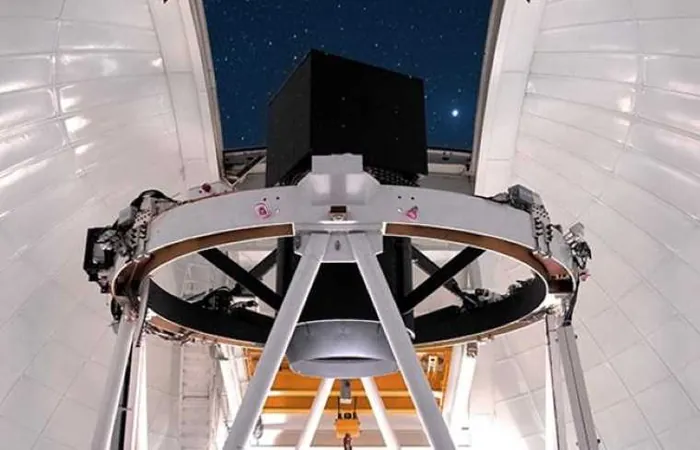
Astronomical Breakthrough: New WEAVE Telescope Reveals Stunning Galactic Collision!
2024-12-06
Author: Wei
In a groundbreaking moment for astrophysics, Europe’s cutting-edge WEAVE telescope has successfully completed its ‘first-light’ activation, capturing spectacular data from a collision between galaxies in the fascinating Stephan’s Quintet. One of the colliding galaxies was clocked at a blistering speed of two million miles per hour, showcasing the intense dynamism of space.
This ambitious European project, financed with 20 million Euros from a coalition of France, Italy, the UK, the Netherlands, and Spain, is hosted at the renowned observatory in La Palma. The star of the show, the Enhanced Area Velocity Explorer (WEAVE), is equipped with a pioneering wide-field spectrograph that enables astronomers to dissect light into its various wavelengths, providing crucial insights into the makeup of stars and galaxies.
Why Stephan’s Quintet is a Stellar Target for Observation
The research team, comprised of 60 dedicated astronomers, chose Stephan’s Quintet as their first target wisely. Discovered in 1877, this group of five galaxies is notorious for its violent interactions, making it an ideal candidate for studying cosmic phenomena. “Stephan’s Quintet acts like a galactic crossroad, where past collisions have created a complex field of debris,” explained Dr. Marina Arnaudova, lead researcher at the University of Hertfordshire.
The current collision has astronomers buzzing with excitement, as the massive shockwave generated by the encounter resembles the sonic boom of a jet fighter, illustrating the raw power of these galactic interactions.
Breaking New Ground with WEAVE’s Spectroscope
Employing WEAVE’s advanced spectroscopic capabilities, the international team could witness the unprecedented collision. “The level of detail this telescope is revealing is simply fantastic,” remarked Professor Gavin Dalton, principal investigator of WEAVE at RAL Space and the University of Oxford. The observations made possible by WEAVE mark a new era in astronomical research, where previously unattainable details come into view.
Unveiling Hidden Secrets of Cosmic Collisions
Using data from WEAVE in conjunction with previous observations from instruments such as the James Webb Space Telescope (JWST) and the Very Large Array (VLA), researchers discovered a never-before-seen shockwave pattern running through varying temperatures and densities of gas in the galactic region. Dr. Arnaudova elaborated on this discovery, noting that the shockwave, when cutting through colder gases, travels at hypersonic speeds. It’s so powerful that it can separate electrons and atoms, leaving behind a glowing trail of ionized gas.
However, the scene shifts considerably when the shockwave interacts with hot gas. Researchers observed that instead of causing chaos, the shockwave compresses the hot gas, resulting in radio waves detectable by radio telescopes.
A New Era of Discovery with WEAVE
The successful activation of WEAVE has led to the publication of its first research paper, showcasing just the beginning of what the next five years hold for this unique observational tool. Dr. Daniel Smith emphasized the significance of this achievement, suggesting it hints at a wealth of discoveries on the horizon.
Professor Dalton echoed this optimism: “Observations like those made by WEAVE provide profound insights into the formation and evolution of faint galaxies often lost in the depths of space.”
Plans are already underway to activate additional instruments that will allow further exploration of the Milky Way as well as distant galaxies. Dr. Marc Balcells, director of the Isaac Newton Group of Telescopes, expressed excitement about future findings. “The data gathered at WEAVE’s first light already show high-impact results. This is just the beginning of a journey filled with potential discoveries.”
The study titled “WEAVE First Light Observations: Origin and Dynamics of the Shock Front in Stephan’s Quintet” was published in the respected Monthly Notices of the Royal Astronomical Society, cementing WEAVE's role in illuminating the mysteries of our universe.
Stay tuned, because what WEAVE uncovers next could change our understanding of the cosmos forever!


 Brasil (PT)
Brasil (PT)
 Canada (EN)
Canada (EN)
 Chile (ES)
Chile (ES)
 España (ES)
España (ES)
 France (FR)
France (FR)
 Hong Kong (EN)
Hong Kong (EN)
 Italia (IT)
Italia (IT)
 日本 (JA)
日本 (JA)
 Magyarország (HU)
Magyarország (HU)
 Norge (NO)
Norge (NO)
 Polska (PL)
Polska (PL)
 Schweiz (DE)
Schweiz (DE)
 Singapore (EN)
Singapore (EN)
 Sverige (SV)
Sverige (SV)
 Suomi (FI)
Suomi (FI)
 Türkiye (TR)
Türkiye (TR)